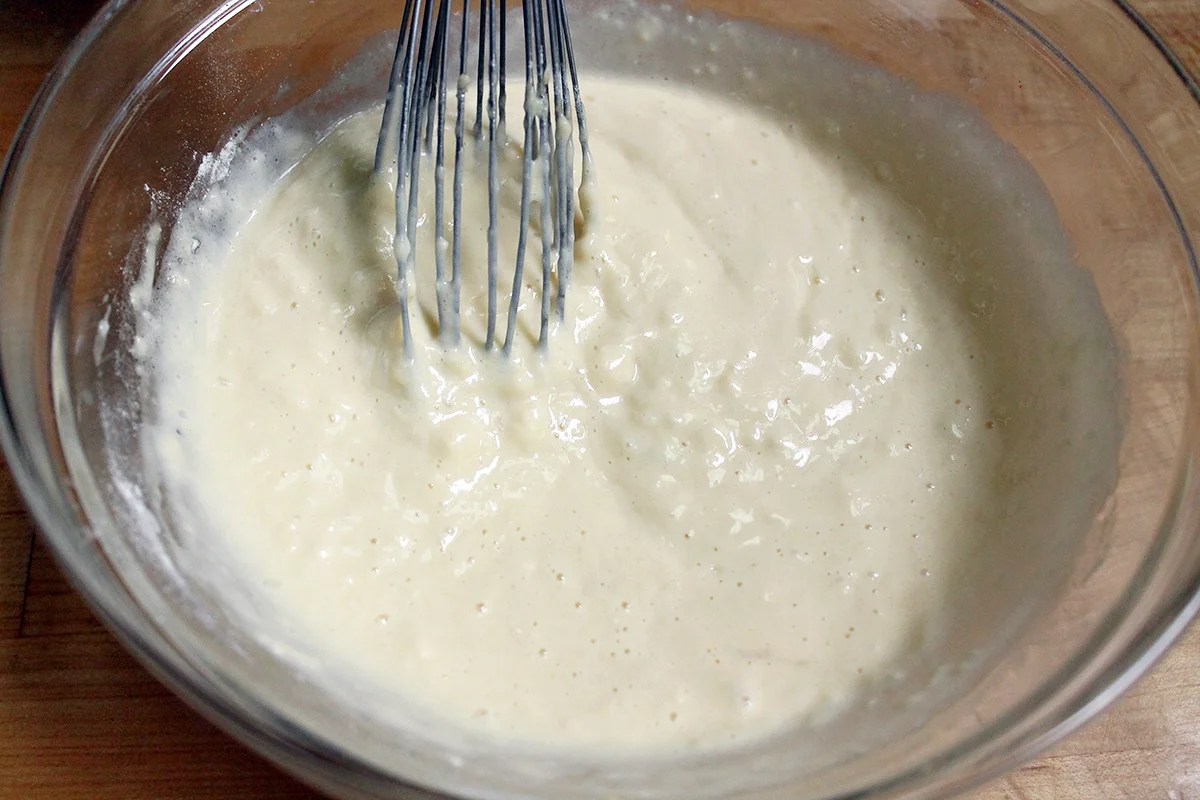Some things are just better when they’re fluffy: pillows, clouds... and pancakes. Definitely pancakes. There’s nothing better than diving into a light, fluffy stack of pancakes. And the key to making pancakes lighter than air is easier than you think. Just don't makethe most common pancake mistake — over-mixing your pancake batter!

Perfectly fluffy pancakes take just a few turns of the wrist.
Over-mixing is an ambitious baker’s enemy. Too much stirring can turn what would otherwise be lofty, tender pancakes into tough, flat disappointments.
Why is mixing your batter too much a fateful pancake mistake? The answer is twofold.

#1: Deflating your batter
Vigorously stirring your batter might help break up some of the residual lumps, but it can also deflate air bubbles. Most pancake recipes have some sort of leavener in them (baking powder or baking soda), which starts to work as soon as it meets liquid.
The batter will begin to lighten and rise slightly once the liquid ingredients are added. Stir gently to maintain as much air in the batter as possible, mixing just until the ingredients are combined.

Resist the urge to break up all the small lumps. They won’t show up in the finished pancakes. Breathe through it and put down your whisk or spoon. Your pancakes are going to be so much lighter because of this simple step — a satisfying reward!
#2: Developing gluten
Aside from deflating the batter, over-mixing is something to avoid for a second reason: it develops gluten.
Now gluten isn’t always something to run and hide from (unless you have an allergy of course, in which case you should head on over to our selection of gluten-free pancake recipes). Gluten is actually desirable in many cases. It gives bagels, pizza crust, and pretzels their signature chew. It helps loaves of bread maintain their structure as they bake.
But you don’t want chewy pancakes. (Do you?)
Gluten is formed when liquid is added to flour and it’s agitated (think mixing, kneading, etc.). As soon as liquid ingredients are added to the dry ingredients, each turn of the bowl will develop gluten.
Remember that gluten is not your friend if cushion-soft pancakes are your goal. You should relax, just like the batter. Tender pancakes will be the result.
How to measure mixing time
There’s a fine line between mixing just enough and too much — some small lumps are OK, but the ingredients should still be thoroughly combined. You shouldn’t see any dry or floury spots on the bottom or sides of the bowl.

My grandmother used to tell me to “count my strokes” when stirring batter. Each time I made a full revolution in the bowl with my spoon or whisk, we’d count aloud to keep track of our progress. For brownies, I mixed the batter for a count of 50. For cakes, she’d tell me to stop at 25.
We didn’t make pancakes much, but I recently used my grandmother’s mixing method when making our Simply Perfect Pancakes. It didn’t take but a mere count of 10 strokes until the batter was just as it should be — barely mixed with just a few small lumps.
Does it really make a difference?
You might be wondering, is it really important to be this vigilant about stirring pancake batter?
I wondered, too. To see if over-stirring truly makes a difference, I mix up two batches of our Simply Perfect Pancakes.

I stir the first batch just until combined, counting about 10 strokes until it's barely mixed. I pour the batter onto a hot griddle and watch the magic happen. (Truth be told, I have to resist the urge to eat the first pancake as soon as it's ready, reminding myself this is part of a purposeful investigation.)
The second batch of pancakes doesn't receive such gentle treatment. I add the milk and mix vigorously until the batter is silky smooth, about 2 minutes of stirring. The batter looks great, but the resulting pancakes? Not so much.

The pancakes from batter mixed for 2 minutes turn out notably flatter. It isn’t quite as enjoyable to cut into a stack of them with the side of my fork. They also have a bit of chew to them, while in comparison the first batch on the left is soft as a sponge. (A sponge for maple syrup, that is.)

It’s worth noting that the second batch still tastes delicious — they just aren’t quite the stack of fluffy pancake heaven I’ve come to expect from this recipe.
So circling back, is it essential to be mindful when mixing your pancake batter? If you want your pancakes to be tall and fluffy, then the answer is yes.

Making perfect pancakes
It’s clear that mixing time is a key factor in determining the texture of your pancakes. Go forward into the weekend and whip up your best batch of pancakes ever, armed with this knowledge:
- For light and fluffy flapjacks, don’t mix too much.
- For flatter, slightly more dense pancakes, mix away. (Hey, you never know — some people may prefer them a bit less tender.)

Choosing your recipe
The world of perfect pancakes doesn’t stop with the one recipe we've used here. We have a full selection of other pancake recipes, including Blueberry Pancakes, Lemon Zephyr Pancakes, Multigrain Pancakes, and even Sourdough Pancakes.
Your perfect pancakes can even include ancient grains.The Complete Guide to Baking with Ancient Grains includes tips about how to use unique flours like amaranth, buckwheat, spelt (and more!) in your morning pancakes.

No time to measure lots of ingredients? We've all been there on weekend mornings. Reach for our Cloud 9 Pancakes, my favorite mix in our Essential Goodness line.
Please share with us your best pancake-making tips in the comments, below.
Thanks to fellow employee-owner Seann Cram for taking the photographs for this blog.